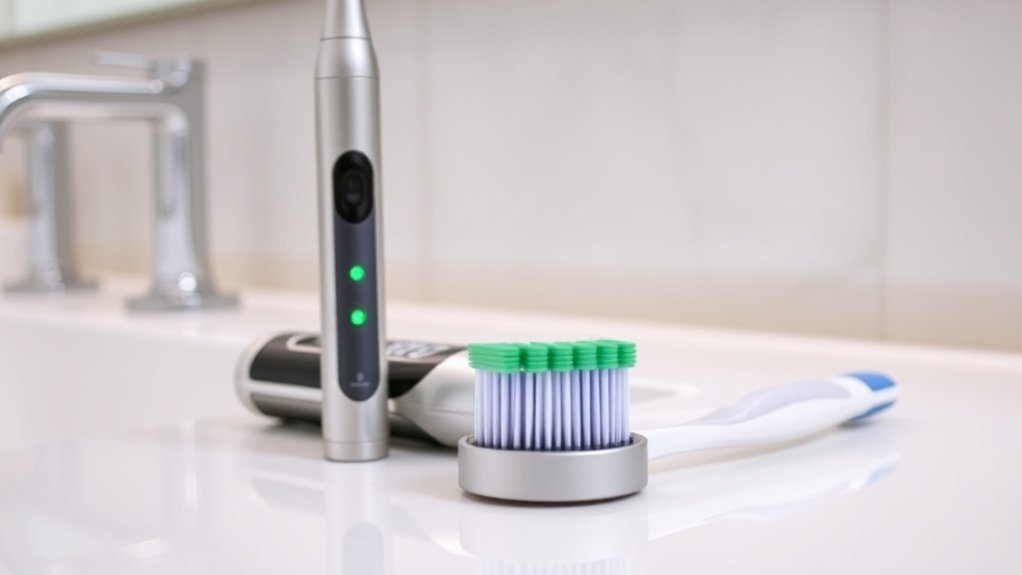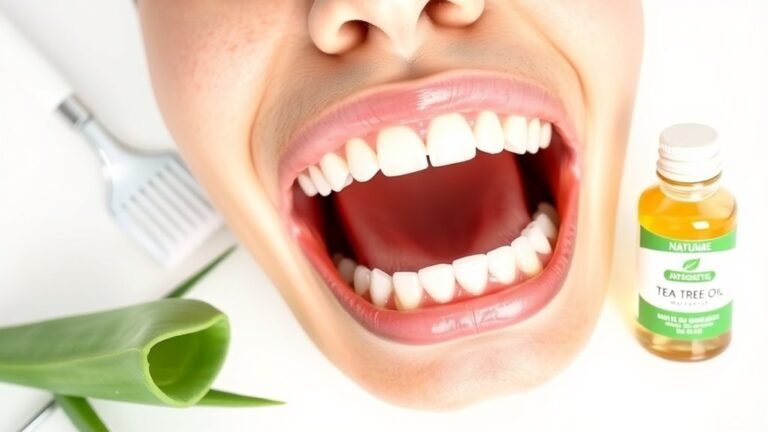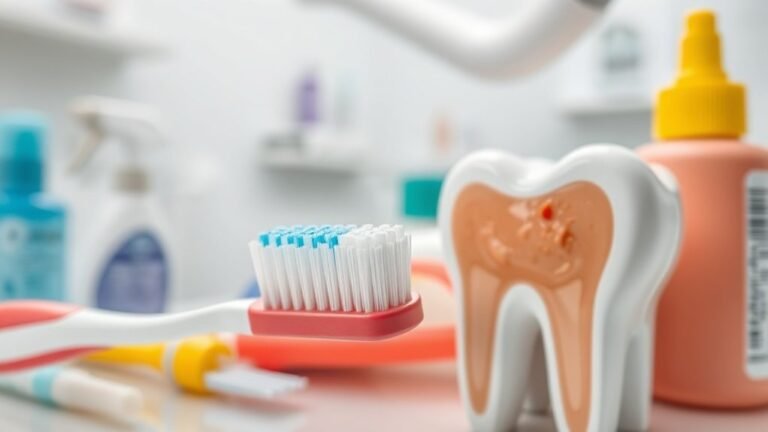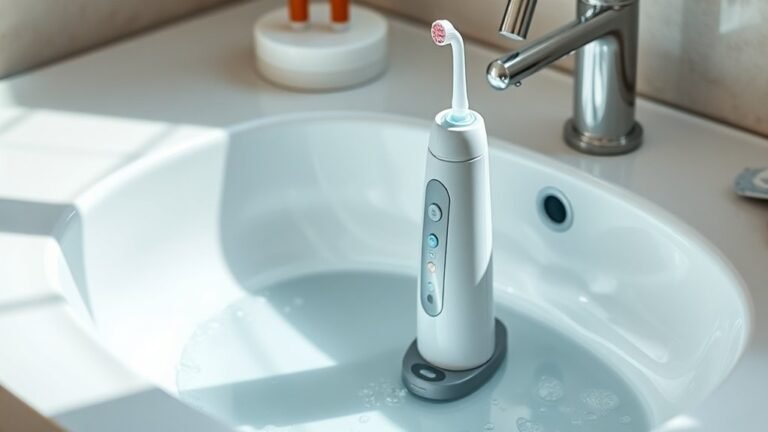Can Switching to Electric Toothbrushes Improve Removal of Dental Plaque
Switching to electric toothbrushes can greatly improve your ability to remove dental plaque. They provide efficient plaque removal through rapid oscillations and consistent brushing motion, often cleaning up to 21% more plaque than manual brushes. Features like built-in timers and pressure sensors help guarantee effective brushing without damaging your gums. While user technique remains important, the advantages of electric models can enhance your oral hygiene routine. Discover more about the benefits, drawbacks, and best practices for electric toothbrushes.
Key Takeaways
- Electric toothbrushes can remove up to 21% more plaque than manual toothbrushes, improving overall cleaning efficiency.
- Their built-in timers ensure a consistent two-minute brushing duration for effective plaque removal.
- Pressure sensors in electric toothbrushes help prevent excessive force, reducing the risk of gum damage.
- Clinical studies indicate significant improvements in plaque scores and gum health among electric toothbrush users.
- Proper technique remains essential; electric brushes enhance effectiveness but should be used correctly for optimal results.
Understanding Dental Plaque and Its Effects on Oral Health
While you may not see it, dental plaque is a sticky film of bacteria that forms on your teeth and gums, and it can have serious consequences for your oral health. This plaque buildup can lead to tooth decay, gum disease, and other complications if not addressed promptly. The bacteria in plaque produce acids that erode tooth enamel and irritate gum tissue. Over time, neglecting to remove dental plaque can result in more severe issues, including infection and tooth loss. Regular brushing and flossing are essential for controlling plaque buildup, but understanding its impact on your oral health helps you stay motivated. By taking proactive steps, you can considerably reduce the risks associated with dental plaque and maintain a healthier smile.
The Mechanics of Electric Toothbrushes
To effectively combat dental plaque and maintain ideal oral health, understanding how electric toothbrushes work can be extremely beneficial. Electric toothbrushes utilize rapid oscillations or rotations to enhance plaque removal compared to manual brushing. These devices encourage a consistent brushing technique, ensuring you cover all tooth surfaces effectively. Many models also come with built-in timers, prompting you to brush for the recommended two minutes, which is essential for ideal plaque reduction. Additionally, the pressure sensors in some electric toothbrushes help prevent excessive force, reducing the risk of gum damage. By embracing the mechanics of electric toothbrushes, you can greatly improve your oral hygiene routine and achieve healthier teeth and gums.
Comparing Electric and Manual Toothbrushes
When comparing electric and manual toothbrushes, you’ll notice significant differences in cleaning efficiency. Research shows that electric toothbrushes often remove more plaque due to their consistent brushing technique. However, your technique with either type plays an essential role in maintaining ideal oral health.
Cleaning Efficiency Comparison
Although many people still rely on manual toothbrushes, research consistently shows that electric toothbrushes offer superior cleaning efficiency in plaque removal. Studies indicate that electric toothbrushes can reduce plaque up to 21% more than manual brushes over a period of three months. This enhanced plaque control is attributed to their ability to deliver consistent, effective brushing motion and pressure. For ideal dental hygiene, electric toothbrushes often come equipped with features like timers and pressure sensors, ensuring you brush for the recommended duration without applying too much force. Consequently, if you’re aiming to improve your dental health, switching to an electric toothbrush can greatly boost your cleaning efficiency and help maintain better plaque control.
User Technique Impact
While electric toothbrushes excel in cleaning efficiency, the technique employed by users also plays a considerable role in plaque removal effectiveness. Your brushing frequency and technique can enhance the benefits of any plaque removal tools, whether you choose an electric or manual toothbrush. Studies show that proper brushing technique—like holding the brush at a 45-degree angle and using gentle circular motions—can notably improve your plaque removal outcomes. Additionally, incorporating an effective oral care routine that includes flossing can further boost your results. Remember, the best toothbrush is only as good as how you use it. So, focus on mastering your technique to maximize the plaque-fighting potential of your chosen toothbrush.
Research Studies on Plaque Removal
In exploring the effectiveness of electric toothbrushes, you’ll find numerous clinical trials that provide valuable insights into plaque removal. These studies often include comparative effectiveness analyses, highlighting how electric models stack up against manual options. By understanding the research, you can make informed decisions about your oral hygiene routine.
Clinical Trials Overview
As researchers continue to explore the effectiveness of electric toothbrushes, numerous clinical trials have emerged that specifically examine their impact on dental plaque removal. These studies focus on how well electric toothbrushes can combat bacterial plaque and contribute to tartar reduction during regular dental cleaning routines. Many trials compare the plaque-removing capabilities of electric toothbrushes to manual ones, often noting significant improvements in plaque scores among electric brush users. Participants typically report easier plaque removal and enhanced overall oral hygiene. The evidence suggests that electric toothbrushes may offer a superior method for maintaining oral health, particularly in reducing bacterial plaque buildup and preventing tartar formation, making them a valuable addition to your dental hygiene arsenal.
Comparative Effectiveness Analysis
To determine the comparative effectiveness of electric versus manual toothbrushes in plaque removal, a variety of research studies have been conducted, yielding valuable insights into their performance. These studies highlight key findings relevant to cavity prevention and oral health products, specifically:
- Electric toothbrushes remove 21% more plaque than manual brushes after three months.
- Users of electric toothbrushes report a significant reduction in gum inflammation.
- Consistent use of electric brushes is linked to lower instances of tooth decay.
- Proper technique with manual brushes can still be effective, but it’s often less consistent than with electric options.
Benefits of Electric Toothbrushes
While you may be accustomed to traditional brushing methods, switching to an electric toothbrush can greatly enhance your oral hygiene routine. Electric toothbrushes are designed to provide more consistent brushing angles and vibrations, effectively reducing oral bacteria that contribute to plaque formation. Studies show that they markedly improve gum health by promoting better plaque removal along the gum line. This helps minimize tartar buildup, which can lead to more serious dental issues if left untreated. Additionally, many electric toothbrushes come with timers and pressure sensors, ensuring you brush for the right duration and with adequate pressure. By making this switch, you not only enhance your daily brushing experience but also take a proactive step towards maintaining ideal oral health.
Potential Drawbacks of Electric Toothbrushes
Although electric toothbrushes offer numerous benefits, there are potential drawbacks that users should consider. Here are some key points to keep in mind:
- Cost: Electric toothbrushes can be more expensive than manual ones, including replacement brush heads.
- Gum Inflammation: Improper use or excessive pressure can lead to gum inflammation, negating some of the oral health benefits.
- Dependency on Batteries: Many electric toothbrushes require charging or battery replacement, which can be inconvenient.
- Limited Effectiveness with Oral Probiotics: While they can improve plaque removal, they may not be as effective when combined with oral probiotics, which target bacteria balance.
Being aware of these drawbacks can help you make a more informed decision regarding your dental tools.
Choosing the Right Electric Toothbrush
Choosing the right electric toothbrush can remarkably impact your oral health and plaque removal efficiency. When selecting an electric toothbrush, consider features like oscillation speed and pressure sensors, which help protect your enamel and guarantee effective brushing. Look for models with interchangeable brush heads tailored for various needs, such as sensitive gums or plaque control. Additionally, consider options that promote a healthy oral microbiome, as some electric toothbrushes offer modes specifically designed to reduce harmful bacteria while preserving beneficial ones. Battery life and ease of use are also essential factors; you’ll want a toothbrush that fits comfortably in your hand and lasts through your daily routine. Prioritizing these features can considerably enhance your dental care experience.
Tips for Maximizing Plaque Removal With Any Toothbrush
Selecting the right electric toothbrush sets the foundation for effective plaque removal, but maximizing your brushing technique is equally important, regardless of the type of toothbrush you use. Here are four tips to enhance your plaque removal:
- Brush for Two Minutes: Spend at least two minutes brushing twice a day to guarantee thorough coverage.
- Use Gentle Pressure: Apply light pressure to avoid aggravating tooth sensitivity while effectively removing plaque.
- Incorporate Flossing: Floss daily to eliminate plaque from between your teeth, where brushes can’t reach.
- Explore Natural Remedies: Consider using baking soda or coconut oil for additional plaque-fighting benefits.
Frequently Asked Questions
How Often Should I Replace My Electric Toothbrush Head?
You should replace your electric toothbrush head every three to four months or sooner if the bristles become frayed. Regular replacement guarantees effective cleaning and maintains ideal oral hygiene, helping you prevent plaque buildup and dental issues.
Can Electric Toothbrushes Cause Gum Recession?
Like a double-edged sword, electric toothbrushes can potentially cause gum recession if used improperly. You should apply gentle pressure and maintain a proper angle to avoid harming your gums while effectively cleaning your teeth.
Are There Specific Techniques for Using an Electric Toothbrush?
Yes, you should position the brush at a 45-degree angle, use gentle pressure, and let the toothbrush do the work. Don’t scrub; instead, move it slowly across each tooth and along the gum line for ideal cleaning.
Do Electric Toothbrushes Work for Braces or Other Dental Appliances?
Yes, electric toothbrushes effectively clean around braces and dental appliances. Studies show they reduce plaque buildup by 21% compared to manual brushes. Their oscillating technology helps you maintain better oral hygiene during orthodontic treatment.
Are There Budget-Friendly Electric Toothbrush Options Available?
Yes, there are budget-friendly electric toothbrush options available. Many brands offer effective models under $50, providing features like timers and multiple brushing modes, ensuring you maintain good oral hygiene without breaking the bank.
Conclusion
As the saying goes, “A stitch in time saves nine.” Investing in an electric toothbrush could be a proactive step toward better oral health. Research shows that these tools often enhance plaque removal compared to manual options. While they come with some drawbacks, the benefits—such as improved cleaning efficiency and built-in timers—can greatly boost your dental hygiene routine. Ultimately, choosing the right toothbrush and employing effective techniques can maximize plaque removal, helping you maintain a healthier smile.






